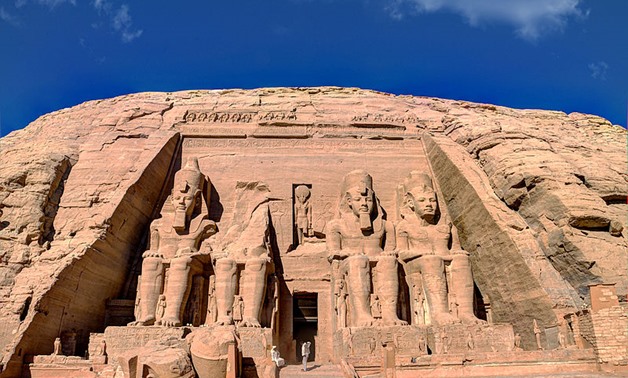
Cover photo – Temple of Abu Simbel – Wikimedia
CAIRO – 31 December 2017: As the year comes to a close, people are coming to Aswan to celebrate New Year’s Eve.
According to Agence France Press, Christmas 2017 was different because many tourists from Africa, Asia and the two Americas, visited Abu Simbel Temple. This year witnessed the highest number of visitors travelling to Aswan and Abu Simbel temple specifically; the number of tourists has increased by 55 percent in comparison to last year, reaching around 6.7 million tourists.
 Entire look of Abu Simbel
Entire look of Abu Simbel
In December 2017, Abu Simbel Temple welcomed a number of tourists celebrating Christmas in a secure atmosphere, where all hotels and cruises were completely booked.
Abu Simbel Temple is one of the most popular monumental buildings in Aswan, which is located at the second cataract of the Nile River.
_and_Small_Temple_of_Nefertari_(right).jpg) Great Temple of Ramses II (left) and Small Temple of Nefertari (right) – Wikimedia
Great Temple of Ramses II (left) and Small Temple of Nefertari (right) – Wikimedia
The temple, carved out of a sandstone cliff on the west bank of the Nile, was discovered twice. It was initially discovered in 1813 by Swiss researcher Johann Ludwig Burckhardt, and then rediscovered in 1817 by Egyptologist Govani Battista.
At the entrance of Abu Simbel Temple, there are two seated statues of the Pharaoh showing the ruler wearing a short kilt, a beautiful headdress which is a double crown with a cobra and a false beard. Next to the statues’ legs, are smaller statues of the Pharaoh’s relatives. The top of the temple is a row of 22 squatting baboon statues. The baboon’s cry was believed to welcome the rising sun.
_and_Small_Temple_of_Nefertari_(right).jpg) Great Temple of Ramses II (left) and Small Temple of Nefertari (right) – Wikimeida
Great Temple of Ramses II (left) and Small Temple of Nefertari (right) – Wikimeida
Further into the temple, there are images and hieroglyphics describing Ramses II’s victory at the battle of Qadesh, in addition to empty storerooms.
According to many scholars, this great temple was created to celebrate the victory of Ramses II over the Hittites at the Battle of Qadesh in 1274 BC. This means that the temple was situated on the border of the conquered lands of Nubia after many military campaigns were carried out by the Pharaoh against Nubia.
 View of Nefertari Temple - Wikimedia
View of Nefertari Temple - Wikimedia
Abu Simbel is made up of two temples. The smaller one was built for Queen Nefertari and has two statues of her and four pharaohs; each about 33 feet (10 meters) in height.
Ramses II built this temple to impress Egypt's southern neighbors, and also to reinforce the status of Egyptian religion in the region; Abu Simbel was one of six rock temples erected in Nubia during the ruling period of Ramses II and its construction took 20 years from 1264 BC to 1244 BC .
UNESCO considers Abu Simbel Temple one of the historical and monumental places that needs to be protected against floods.

_and_Small_Temple_of_Nefertari_(right).jpg)
_and_Small_Temple_of_Nefertari_(right).jpg)

Comments
Leave a Comment